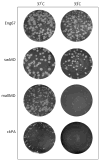Assessment of transmission, pathogenesis and adaptation of H2 subtype influenza viruses in ferrets
- PMID: 25659818
- PMCID: PMC5804491
- DOI: 10.1016/j.virol.2015.01.002
Assessment of transmission, pathogenesis and adaptation of H2 subtype influenza viruses in ferrets
Abstract
After their disappearance from the human population in 1968, influenza H2 viruses have continued to circulate in the natural avian reservoir. The isolation of this virus subtype from multiple bird species as well as swine highlights the need to better understand the potential of these viruses to spread and cause disease in humans. Here we analyzed the virulence, transmissibility and receptor-binding preference of two avian influenza H2 viruses (H2N2 and H2N3) and compared them to a swine H2N3 (A/swine/Missouri/2124514/2006 [swMO]), and a human H2N2 (A/England/10/1967 [Eng/67]) virus using the ferret model as a mammalian host. Both avian H2 viruses possessed the capacity to spread efficiently between cohoused ferrets, and the swine (swMO) and human (Eng/67) viruses transmitted to naïve ferrets by respiratory droplets. Further characterization of the swMO hemagglutinin (HA) by x-ray crystallography and glycan microarray array identified receptor-specific adaptive mutations. As influenza virus quasispecies dynamics during transmission have not been well characterized, we sequenced nasal washes collected during transmission studies to better understand experimental adaptation of H2 HA. The avian H2 viruses isolated from ferret nasal washes contained mutations in the HA1, including a Gln226Leu substitution, which is a mutation associated with α2,6 sialic acid (human-like) binding preference. These results suggest that the molecular structure of HA in viruses of the H2 subtype continue to have the potential to adapt to a mammalian host and become transmissible, after acquiring additional genetic markers.
Keywords: Ferret; Hemagglutinin; Influenza; Transmission.
Published by Elsevier Inc.
Figures





Similar articles
-
Antigenically Diverse Swine Origin H1N1 Variant Influenza Viruses Exhibit Differential Ferret Pathogenesis and Transmission Phenotypes.J Virol. 2018 May 14;92(11):e00095-18. doi: 10.1128/JVI.00095-18. Print 2018 Jun 1. J Virol. 2018. PMID: 29540597 Free PMC article.
-
Pathogenicity and transmission of a swine influenza A(H6N6) virus.Emerg Microbes Infect. 2017 Apr 12;6(4):e17. doi: 10.1038/emi.2017.3. Emerg Microbes Infect. 2017. PMID: 28400591 Free PMC article.
-
Receptor specificity and transmission of H2N2 subtype viruses isolated from the pandemic of 1957.PLoS One. 2010 Jun 21;5(6):e11158. doi: 10.1371/journal.pone.0011158. PLoS One. 2010. PMID: 20574518 Free PMC article.
-
Hemagglutinin Stability and Its Impact on Influenza A Virus Infectivity, Pathogenicity, and Transmissibility in Avians, Mice, Swine, Seals, Ferrets, and Humans.Viruses. 2021 Apr 24;13(5):746. doi: 10.3390/v13050746. Viruses. 2021. PMID: 33923198 Free PMC article. Review.
-
Avian influenza virus transmission to mammals.Curr Top Microbiol Immunol. 2014;385:137-55. doi: 10.1007/82_2014_387. Curr Top Microbiol Immunol. 2014. PMID: 25048542 Review.
Cited by
-
Sequential Transmission of Influenza Viruses in Ferrets Does Not Enhance Infectivity and Does Not Predict Transmissibility in Humans.mBio. 2022 Dec 20;13(6):e0254022. doi: 10.1128/mbio.02540-22. Epub 2022 Oct 27. mBio. 2022. PMID: 36300929 Free PMC article.
-
The Pandemic Threat of Emerging H5 and H7 Avian Influenza Viruses.Viruses. 2018 Aug 28;10(9):461. doi: 10.3390/v10090461. Viruses. 2018. PMID: 30154345 Free PMC article. Review.
-
Inhibiting influenza virus transmission using a broadly acting neuraminidase that targets host sialic acids in the upper respiratory tract.mBio. 2024 Feb 14;15(2):e0220323. doi: 10.1128/mbio.02203-23. Epub 2024 Jan 11. mBio. 2024. PMID: 38206008 Free PMC article.
-
Varying Viral Replication and Disease Profiles of H2N2 Influenza in Ferrets Is Associated with Virus Isolate and Inoculation Route.J Virol. 2022 Jul 27;96(14):e0073222. doi: 10.1128/jvi.00732-22. Epub 2022 Jul 11. J Virol. 2022. PMID: 35862678 Free PMC article.
-
Pathogenicity testing of influenza candidate vaccine viruses in the ferret model.Virology. 2017 Nov;511:135-141. doi: 10.1016/j.virol.2017.08.024. Epub 2017 Aug 29. Virology. 2017. PMID: 28846898 Free PMC article.
References
-
- CCP4. The CCP4 suite: programs for protein crystallography. Acta Crystallogr D Biol Crystallogr. 1994;50(Pt 5):760–763. - PubMed
Publication types
MeSH terms
Substances
Grants and funding
LinkOut - more resources
Full Text Sources
Other Literature Sources
Research Materials

